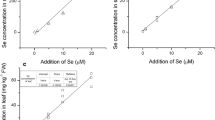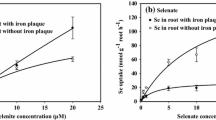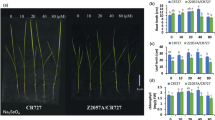Abstract
Aim
Selenium uptake capacity can vary among rice genotypes; however, the processes driving these high- and low-Se-accumulating rice cultivars have not yet been defined.
Methods
The root architecture, selenium uptake, and transporter genes (Sultr2;1 and Ospt2) and selenium-binding protein (SBP1) expression of high- and low-Se rice cultivars were determined in agar culture experiment with different selenite and selenate concentrations.
Results
Root architecture analysis showed that the toxicity of selenite was greater than that of selenate for both rice cultivars, and the Se tolerance of the high-Se rice for selenite was greater than that of the low-Se rice. The uptake rate of selenite was greater than that of selenate, and the high-Se rice accumulated a higher Se concentration in the roots. However, selenite translocation via the xylem was limited, and the two rice cultivars accumulated similar amounts of Se in shoots when it was supplied as selenite. By contrast, selenate was highly mobile via xylem transport, and the high-Se rice accumulated a higher Se concentration in the shoots when it was supplied. The transcript levels of the Sultr2;1 and Ospt2 genes were higher in the high-Se rice than in the low-Se rice with selenite or selenate application. The application of selenite or selenate increased the SBP1 transcript level in the high-Se rice but decreased the transcript level of SBP1 in the low-Se rice.
Conclusions
The increased expression of phosphate and sulfate transporters and improved root architecture may explain how the high-Se rice cultivar can take up more selenite and selenate, respectively.






Similar content being viewed by others
References
Agalou A, Roussis A, Spaink HP (2005) The arabidopsis selenium-binding protein confers tolerance to toxic levels of selenium. Funct Plant Biol 32(10):881–890
Baydar N, Brooks-Gunn J, Furstenberg FF, Baydar N, Brooks-Gunn J, Furstenberg FF (2015) Effects of sulfate on the uptake and translocation of selenium in wheat under selenite and selenate conditions. Acta Sci Circumst 35(3):815–829
Chen GH, Yan W, Yang SP, Wang A, Zhu YL (2015) Overexpression of rice phosphate transporter gene OsPT2 enhances tolerance to low phosphorus stress in soybean. J Agric Sci Technol 17(2):469–482
Du QJ, Zhang YF, Zeng B, Li GQ, Tang SM (2009) Screening of rich selenium of rice variety from Hainan regions rich in selenium. Soil Fertil Sci Chin 1:46–49
Dutilleul C, Jourdain A, Bourguignon J, Hugouvieux V (2008) The arabidopsis putative selenium-binding protein family: expression study and characterization of SBP1 as a potential new player in cadmium detoxification processes. Plant Physiol 147(1):239–251
Freeman JL, Tamaoki M, Stushnoff C, Quinn CF, Cappa JJ, Devonshire J, Fakra SC, Marcus MA, McGrath SP, Hoewyk DV, Pilon-Smits EAH (2010) Molecular mechanisms of selenium tolerance and hyperaccumulation in stanleyapinnata. Plant Physiol 153(4):1630–1652
Gissel-Nielsen G (2010) Uptake and distribution of added selenite and selenate by barley and red clover as influenced by Sulphur. J Sci Food Agric 24(6):649–655
Hawrylak-Nowak B (2013) Comparative effects of selenite and selenate on growth and selenium accumulation in lettuce plants under hydroponic conditions. Plant Growth Regul 70:149–157
Hu AY, Che J, Shao JF, Yokosho K, Zhao XQ, Shen RF, Ma JF (2018) Silicon accumulated in the shoots results in down-regulation of phosphorus transporter gene expression and decrease of phosphorus uptake in rice. Plant Soil 423(1–2):317–325
Huang Q, Yu Y, Wang Q, Luo Z, Jiang R, Li H (2015) Uptake kinetics and translocation of selenite and selenate as affected by iron plaque on root surfaces of rice seedlings. Planta 241(4):907–916
Huang T, Jiang Z, Xing Y, Liao Q, Liang P, Liu Y (2017a) Effects of exogenous selenium on Paddy Rice growth, selenium uptake and accumulation. J Agric Resour Environ 34(5):449–455
Huang QQ, Wang Q, Wan YN, Yu Y, Jiang RF, Li HF (2017b) Application of x-ray absorption near edge spectroscopy to the study of the effect of Sulphur on selenium uptake and assimilation in wheat seedlings. Biol Plant 61(4):1–7
Jia H, Song Z, Wu F, Ma M, Li Y, Han D, Yang Y, Zhang S, Cui H (2018) Low selenium increases the auxin concentration and enhances tolerance to low phosphorous stress in tobacco. Environ Exp Bot 153:127–134
Joy EJM, Ander EL, Broadley MR, Young SD, Chilimba ADC, Hamilton EM, Watts MJ (2016) Elemental composition of malawian rice. Environ Geochem Health 39(4):1–11
Kahakachchi C, Boakye HT, Uden PC, Tyson JF (2004) Chromatographic speciation of anionic and neutral selenium compounds in se-accumulating brassica juncea (indian mustard) and in selenized yeast. J Chromatogr A 1054(1–2):303–312
Leduc DL, Tarun AS, Montes-Bayon M, Meija J, Malit MF, Wu CP, AbdelSamie M, Chiang C, Tagmount A, deSouza M, Neuhierl B, Böck A, Caruso J, Terry N (2004) Overexpression of selenocysteine methyltransferase in arabidopsis and indian mustard increases selenium tolerance and accumulation. Plant Physiol 135(1):377–383
Li HF, Mcgrath SP, Zhao FJ (2008) Selenium uptake, translocation and speciation in wheat supplied with selenate or selenite. New Phytol 178(1):92–102
Liu X, Ye Y, Deng X, Li M, Wei Z, Zhao Z (2016) Effects of sulfur and sulfate on selenium uptake and quality of seeds in rapeseed (brassicanapus l.) treated with selenite and selenate. Environ Exp Bot 135:13–20
Longchamp M, Angeli N, Castrec-Rouelle M (2013) Selenium uptake in zea mays supplied with selenate or selenite under; hydroponic conditions. Plant Soil 362(1–2):107–117
Malheiros RSP, Costa LC, Ávila RT, Pimenta TM, Teixeira LS, Brito FAL, Zsogon A, Araujo WL, Ribeiro DM (2019) Selenium downregulates auxin and ethylene biosynthesis in rice seedlings to modify primary metabolism and root architecture. Planta 250(3):333–345
Mao H, Wang Z, Lyons G (2015) Germination-enhancing and zinc-sparing roles for selenium in broccoli. Acta Agric Scand 65(2):141–149
Maruyama-Nakashita A (2016) Combinatorial use of sulfur-responsive regions of sulfate transporters provides a highly sensitive plant-based system for detecting selenate and chromate in the environment. Soil Sci Plant Nutr 62(4):1–6
Mehdawi AEF, Jiang Y, Guignardi ZS, Esmat A, Pilon M, Pilon-Smits EAH, Schiavon M (2018) Influence of sulfate supply on selenium uptake dynamics and expression of sulfate/selenate transporters in selenium hyperaccumulator and nonhyperaccumulator brassicaceae. New Phytol 217(1):194–205
Munna R (2005) Genes and salt tolerance: bring them together. New Phytol 167:645–663
Muthayya S, Sugimoto JD, Montgomery S, Maberly GF (2015) An overview of global rice production, supply, trade, and consumption. Ann N Y Acad Sci 1324(1):7–14
Neu B, Hermuth H, Vaupel W, Classen M, Schepp W (2015) Effects of sulfate on the uptake and translocation of selenium in wheat under selenite and selenate conditions. Acta Sci Circumst 35(3):815–829
Pilon-Smits EAH (2015) Selenium in plants. In: Lüttge U, Beyschlag W (eds) Progress in botany. Progress in botany (genetics - physiology - systematics - ecology). Springer, Cham
Pound MP, French AP, Atkinson JA, Wells DM, Bennett MJ, Pridmore T (2013) Rootnav: navigating images of complex root architectures. Plant Physiol 162(4):1802–1814
Schiavon M, Pittarello M, Pilon-Smits EAH, Wirtz M, Hell R, Malagoli M (2012) Selenate and molybdate alter sulfate transport and assimilation in brassica juncea l. czern.: implications for phytoremediation. Environ Exp Bot 75(4):41–51
Schild F, Kiefferjaquinod S, Palencia A, Cobessi D, Sarret G, Zubieta C, Jourdain A, Dumas R, Forge V, Testemale D, Bourguignon J, Hugouvieux V (2014) Biochemical and biophysical characterization of the selenium-binding and reducing site in arabidopsis thaliana homologue to mammals selenium-binding protein 1. J Biol Chem 289(46):31765–31776
Shinmachi F, Buchner P, Stroud JL, Parmar S, Zhao FJ, Mcgrath SP, Hawkesford M (2010) Influence of sulfur deficiency on the expression of specific sulfate transporters and the distribution of sulfur, selenium, and molybdenum in wheat. Plant Physiol 153(1):327–336
Silva VM, Boleta EHM, Lanza MGDB, Lavres J, Martins JT, Santos EF, Santos FLM, Putti FF, Junior EF, White PJ, Broadley MR, Carvalho HWP, Reis AR (2018) Physiological, biochemical, and ultrastructural characterization of selenium toxicity in cowpea plants. Environ Exp Bot 150:172–182
Sors TG, Ellis DR, Salt DE (2005) Selenium uptake, translocation, assimilation and metabolic fate in plants. Photosynth Res 86(3):373–389
Terry N, Zayed AM, de Souza MP, Tarun AS (2000) Selenium in higher plants. Annu Rev Plant Physiol Plant Mol Biol 51(51):401–432
Tullo PD, Versini A, Bueno M, Hécho IL, Thiry Y, Biron P, Castrec-Rouelle M, Pannier P (2015) Stable isotope tracing: a powerful tool for selenium speciation and metabolic studies in non-hyperaccumulator plants (ryegrass loliumperenne l.). Anal Bioanal Chem 407(30):9029–9042
Valassakis C, Livanos P, Minopetrou M, Haralampidis K, Roussis A (2018a) Promoter analysis and functional implications of the selenium binding protein (SBP) gene family in arabidopsis thaliana. J Plant Physiol 224-225:19–29
Valassakis C, Livanos P, Minopetrou M, Haralampidis K, Roussis A (2018b) Promoter analysis and functional implications of the selenium binding protein (SBP) gene family inArabidopsis thaliana. J Plant Physiol 224-225:19–29
Van Hoewyk D (2013) A tale of two toxicities: malformed selenoproteins and oxidative stress both contribute to selenium stress in plants. Ann Bot 112:965–972
Van Hoewyk D, Takahashi H, Inoue E, Hess A, Tamaoki M, Pilon-Smits AH (2008) Transcriptome analyses give insights into selenium-stress responses and selenium tolerance mechanisms in Arabidopsis. Physiol Plant 132:236–253
Wu Z, Wang F, Liu S, Du Y, Li F, Du R, Wen D, Zhao J (2016) Comparative responses to silicon and selenium in relation to cadmium uptake, compartmentation in roots, and xylem transport in flowering Chinese cabbage (brassica campestris l. ssp. chinensis var. utilis) under cadmium stress. Environ Exp Bot 131:173–180
Yoshida M, Yasumoto K (1987) Selenium contents of rice grown at various sites in Japan. J Food Compos Anal 1(1):71–75
Yu XZ, Gu JD (2008) Differences in uptake and translocation of selenate and selenite by the weeping willow and hybrid willow. Environ Sci Pollut Res 15(6):499–508
Zhang Y, Pan G, Chen J, Hu Q (2003) Uptake and transport of selenite and selenate by soybean seedlings of two genotypes. Plant Soil 253(2):437–443
Zhang L, Shi W, Wang X (2006) Difference in selenite absorption between high- and low-selenium rice cultivars and its mechanism. Plant Soil 282:183–193
Zhang L, Hu B, Li W, Che R, Deng K, Li H, Yu F, Ling H, Li Y, Chu C (2014) OsPT2, a phosphate transporter, is involved in the active uptake of selenite in rice. New Phytol 201(4):1183–1191
Zhang M, Xing GF, Tang SH, Pang YW, Yi Q, Huang QY, Huang X, Huang JF, Li P, Fu HT (2019) Improving soil selenium availability as a strategy to promote seleniumuptake by high-se rice cultivar. Environ Exp Bot 163:45–54
Zhou XB, Yu SH, Lai F (2014) Mechanisms of differences in selenium absorption and transport between rice plants different in cultivar. Acta Pedol Sin 3:594–599
Zhu YG, Pilon-Smits EAH, Zhao FJ, Williams PN, Meharg AA (2009) Selenium in higher plants: understanding mechanisms for biofortification and phytoremediation. Trends Plant Sci 14(8):436–442
Acknowledgements
We would like to thank Professor Martin Broadley (University of Nottingham, UK) for facilitating the analysis and for suggestions on the manuscript. This work was supported by the National Natural Science Funds of China (Grant No.31872176; 31501835), the Natural Science Foundation of Guangdong Province (Grant No.2015A030310449), the Science and Technology Project of Guangzhou (Grant No. 201804010341) and the President’s Special Fund of the Guangdong Academy of Agricultural Sciences (Grant No. 201938).
Author information
Authors and Affiliations
Corresponding author
Additional information
Responsible Editor: Ismail Cakmak.
Publisher’s note
Springer Nature remains neutral with regard to jurisdictional claims in published maps and institutional affiliations.
Rights and permissions
About this article
Cite this article
Zhang, M., Wilson, L., Xing, G. et al. Optimizing root architecture and increasing transporter gene expression are strategies to promote selenium uptake by high-se accumulating rice cultivar. Plant Soil 447, 319–332 (2020). https://doi.org/10.1007/s11104-019-04383-5
Received:
Accepted:
Published:
Issue Date:
DOI: https://doi.org/10.1007/s11104-019-04383-5




